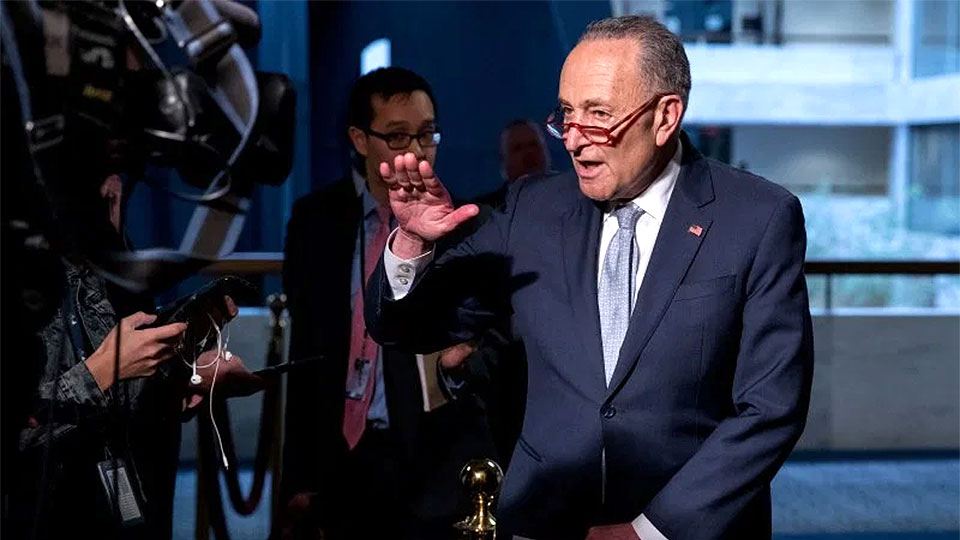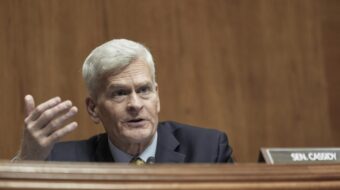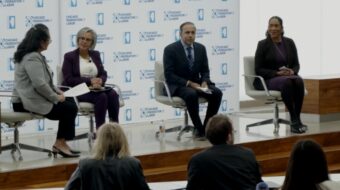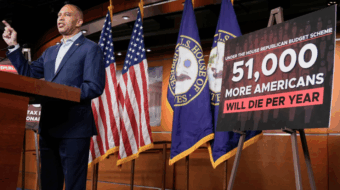
WASHINGTON—As Congress struggles over passage of a big coronavirus aid bill, there seems to be quite a difference between what’s in it – or may be in it – and what progressive economists say should be in it.
Congressional leaders and Trump Treasury Secretary Stephen Mnuchin worked over the weekend of March 21-22 to craft a measure, costing up to $2 trillion both parties could agree upon.
Preliminary Senate votes started the night of March 22 on it, with passage there scheduled afterwards, but Majority Leader Mitch McConnell, R-Ky., threw a monkey wrench in the talks.
He declared the ruling Republicans would come up with their own version and dared the Democrats to do the same thing. The Dems accepted his challenge and crafted their own, more people-oriented bill.
And once the Senate acts, House members must get back to town to do their jobs and work on that stimulus bill. They took an Easter-Passover recess and went home to their districts after votes on two other relief bills the week before, but Speaker Nancy Pelosi, D-Calif., flew back from San Francisco to D.C. on March 21 for the sit-downs with the other leaders on this big bill.
With the first votes looming, here are key provisions that we know, so far, are in the legislation, or not:
IN: Payments to adults ($1,200 each) and for each minor child ($600). One big question is whether the checks will be one-time or once a month. The Republicans want tax rebates to people who file returns, but the Democrats – plus Sen. Mitt Romney, R-Utah – won that argument for direct checks. The GOP also tried to limit payments to adults with no income tax liability to $600 but backed down.
There’s no question the coronavirus pandemic and resulting closures and cancellations of everything from airline flights to restaurants to auto production lines, is going to produce a recession. In a “normal” slump, says Josh Bivens of the Economic Policy Institute, factory jobs are the first to go. Not this time.
“A coronavirus recession is much more laser-targeted at low-wage and low-hours jobs in service industries. This should increase job loss relative to output loss. Given that workers in these sectors are likely to have very little savings to tide them over the economy’s downturn, the ripple effect from the first round of job losses is likely to be far greater,” he warned.
“The checks should continue monthly until economic conditions allow for them to start winding down,” Bivens added (his emphasis). “Put simply, the federal government needs to finance a much larger part of household consumption in the coming months, transfer significant fiscal aid to state governments, and ramp up direct government purchases.”
NOT IN YET: A really big expansion of jobless benefits – and of states hiring workers, even if they must telework – to handle the flood of claims. New claims for unemployment insurance rose from 211,000 in the week ending March 12 to 281,000 in the week ending March 19, and it’s only going to get worse, Bivens predicts.
Bivens forecasts the U.S. could have three million more jobless workers, due to the coronavirus shutdowns and lockdowns, within a few months. Even Mnuchin told Senate Republicans behind closed doors that joblessness, which was 3.5% in February, could rise to 20%.
Senate Democrats argued for six weeks jobless benefits at full pay levels, not current partial pay that varies by state, and waiving waiting periods for jobless benefits.
Not only will a flood of jobless claims come rolling in, but they’ll swamp state jobless systems at a time when state revenues are falling, due to the coronavirus’s impact on sales and income tax revenues. So Bivens says the states will need more money to handle the rising tide of claims, and the increased sums of money they’ll have to pay out, too.
State unemployment trust funds are financed by payroll taxes on firms, but when states run short they borrow money from the federal government. Be prepared for a lot of borrowing, Bivens says.
NOT IN: There is no provision to assist the millions of seniors on Social Security. Democrats want a $200 per month increase in Social Security benefits for the duration of the crisis.
NOT IN: Government forcing firms to make needed supplies — N95 masks and respirators, isolation rooms and equipment, medical gloves and gowns – front-line health care workers need to protect themselves against the contagion so they, in turn, can treat or protect everyone else.
That was the point of angry Teachers President Randi Weingarten in a March 20 afternoon telephone press conference, joined by leaders of AFT’s nurses’ state affiliates from New York, Oregon, Michigan, and Connecticut. There are huge shortages of all those items, Weingarten and her nurse leaders said. They declared the government should step in and order firms now idled from producing consumer goods to convert to producing that protective personal equipment.
IN: $350 billion in aid to “small businesses.” What’s unclear so far is (a) how small is “small,” and (b) whether the money will be disbursed only to small businesses that previously sought and got federal SBA loans.
IN, BUT…: Food stamps. The $8.3 billion aid bill of March 18 expanded food stamp eligibility, but it didn’t get rid of a 1996 GOP-imposed rule that single adults without kids qualify for food stamps only if they worked at least 80 hours a month. And those same rules limit food stamps to three months. The food stamp maximum, economists point out, for such single people is $194 monthly – and no food stamp recipient can use the money on “hot food, food prepared for immediate consumption, pet food, cleaning supplies, and hygiene items.”
IN: More aid to hospitals and other parts of the health infrastructure, to help them cope with the thousands of new patients needing treatment for the coronavirus. That aid would total tens of billions of dollars, said Senate Health Committee Chairman Lamar Alexander, R-Tenn. He wasn’t specific about sums of what the money could be used for.
In a sign of how hospitals are already getting overwhelmed, Los Angeles officials on March 22 ordered two now-shuttered hospitals to reopen. One closed its doors early this year after a bankruptcy filing. The city closed the other in 2018 because it wasn’t earthquake-proof. Now, L.A. needs their beds for present and potential coronavirus victims.
IN: $50 billion in aid to the airlines. GOP President Donald Trump also wants aid to the hotel, motel and cruise ship industries, where bookings have crashed, layoffs have started and even more loom.
Dean Baker and three other colleagues at the Center for Economics and Policy Research question why the feds should step in and help the airlines and cruise lines that didn’t have the foresight, after prior sinkings and disease outbreaks (cruises) and bankruptcies (airlines), to set aside profits to deal with distress, rather than distributing bonuses, big paychecks and stock options to corporate honchos and Wall Street shareholders. They also point out the airlines, in particular, could – again – file for Chapter 11 bankruptcy reorganization, just as they did after revenues crashed following the 9/11 attacks.
This time, though, Baker and his colleagues declare, airline and cruise workers’ pay and pensions should be put at the front of the bankruptcy line if those firms must file.
“If the current cruise ship industry couldn’t foresee health issues, given its history, its shareholders deserve to be cleaned out on their investments,” they wrote. “A bankrupt cruise industry does not mean additional unemployed cruise ship workers, it means they will be working for new owners who, in theory, have the foresight to buy insurance that includes pandemics.”
“If airlines go bankrupt, the retirement benefits of tens or maybe hundreds of thousands of workers could be damaged through no fault of their own. It is not a worker’s job to make decisions on insurance! We recommend ensuring a prepackaged bankruptcy policy that protects these benefits, which are often the lowest priority under bankruptcy law, as was done with the auto industry,” in the Great Recession.
“Income tax cuts, or further business tax cuts, or slight pro-business tweaks to the 2017 tax cut will likely be offered up. This is ideological opportunism that nobody should take seriously,” Bivens said.
The one exception, some economists say, should be aid for firms that don’t lay off workers.
IN: Paid sick leave for millions of workers. OUT: But not for everybody. And, say Baker and his colleagues, it’s not long enough.
The $8.3 billion aid law Congress passed and Trump signed on March 18 includes 14 days of paid sick leave for workers who are diagnosed with or in quarantine because of the coronavirus, officially called COVID-19. But the law doesn’t cover workers at firms with at least 500 workers – and that’s 7.4 million workers. And firms that employ 50 workers or fewer can seek waivers (exemptions) from the law.
So the law covers workers at a large local independent grocery store, not a chain store, but not at large non-union grocers like Walmart. Analyses of federal data by the Washington Post show 63% of food and accommodations workers don’t have company-paid sick leave. Nor do 35% of retail workers and 15% of health care workers.
So while unionized nurses might have access to paid sick leave – if they can afford it – non-union home health care aides don’t.
Baker and his colleagues want to “make paid sick leave expansion both real and permanent. A minimum number of paid sick days should be no less than 80 hours for full-time workers, pro-rated hours for part-time, and should be a federally-mandated employment standard, similar to minimum wage.”
That means “an inclusive paid family and medical leave program with adequate wage replacement rates (possibly progressive), a modern definition of family and family-like relationships, and with a guaranteed right of return to an old job or similar job protection,” they added.
“That ensures the system is usable by single moms, communities of color, disabled people, LGBTQ individuals, and others. It also needs to be made permanent so that we minimize both future pandemics and even the ‘run-of-the-mill flu’ which kills thousands annually.”
UNKNOWN: Several of the economists made the point that a lot of the benefits of any aid package – not to mention access to teachers and professors as schools and universities close their campuses — are accessible by computer, but what happens if you don’t have a computer?
IN, BUT ONLY FOR A MONTH OR SO, SO FAR: A ban on evictions. Gov. Larry Hogan, D-Md., has already instituted a statewide ban on public housing and private landlord evictions. Rep. Ayanna Pressley, D-Mass., and Sens. Jeff Merkley, D-Ore., Elizabeth Warren, D-Mass., and Bernie Sanders, Ind-Vt., have already asked Trump’s Housing and Urban Development Department and private landlord associations for a ban on all evictions. So has the National Low-Income Housing Coalition.
“Suspend evictions, foreclosures and utility shutoffs nationwide,” Sanders tweeted on March 21, due to people losing jobs, income and the ability to pay their rent, mortgage payments, and bills. Except in Washington state, the private landlords have been silent. But the Washington state landlords groups agreed to at least a temporary ban, and Trump’s HUD is suspending evictions and foreclosures until May 1.










